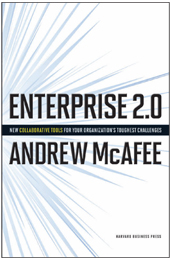Connecting the Dots in the Enterprise
Andrew McAfee’s new book looks at Enterprise 2.0 tools as a way to span organizational networks.

In a Spring 2006 MIT Sloan Management Review article, “Enterprise 2.0: The Dawn of Emergent Collaboration,” Andrew McAfee first started to popularize the term “Enterprise 2.0” to describe the use of Web 2.0 collaboration technologies such as wikis and blogs within organizations. McAfee, now a principal research scientist at the MIT Center for Digital Business, has since continued his research into business use of what he calls “emergent social software platforms,” which by now range from wikis and blogs to Facebook and Twitter.
McAfee recently wrote a new book called Enterprise 2.0: New Collaborative Tools for Your Organization’s Toughest Challenges (Harvard Business Press, 2009). MIT Sloan Management Review senior editor Martha E. Mangelsdorf spoke with McAfee about his book — and his latest thinking on Enterprise 2.0. Here are a few excerpts from the interview, edited for clarity.
In your new book, you write about how Enterprise 2.0 tools fit into social network theory — and about strong ties, weak ties and people we don’t have ties with at all. Can you say more about that?
The book’s discussion of social network analysis grew out of a frustration I had trying to explain why managers should be interested in Facebook. When I started using Facebook, I realized it was a powerful tool for business purposes, but I couldn’t communicate that well to executive audiences. So I was really frustrated — and then I realized that, when I was a doctoral student, I’d read a wonderful paper by Mark Granovetter,“The Strength of Weak Ties,”that actually provided a great way to explain the benefits of tools like Facebook.
The paper is really counterintuitive. We rely very closely on our strong ties — our close colleagues. But Granovetter emphasized that if we want novelty and innovation, our weak ties, or our more distant colleagues and acquaintances, are actually the place to go first, because they have by definition less overlap with our knowledge base and our social network. Weak ties are hugely valuable.
There’s also another great body of social network literature that talks about the tragedy of not having a tie at all. That’s what happens when social networks are isolated from each other — and there’s what’s called a structural hole between them. Then there may be great work going on in both networks, but they’re not going to be aware of each other, and there’s going to be no cross-pollination.

Comments (4)
Steve Abente
Sean Cavanaugh
Alice Newton
Andrew Goddard